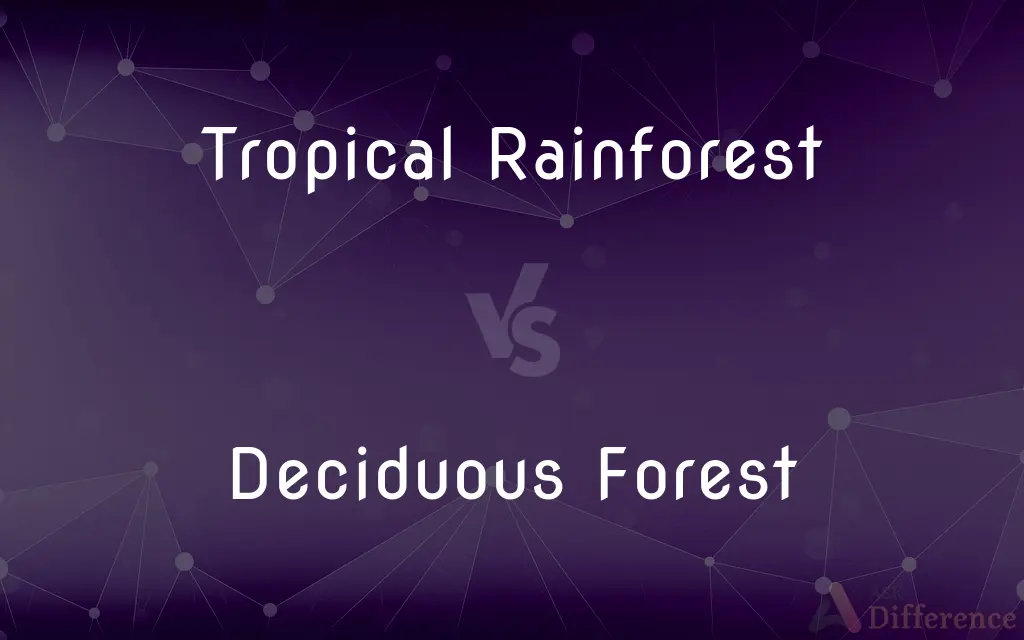Tropical Rainforest vs. Deciduous Forest — What's the Difference?
Edited by Tayyaba Rehman — By Fiza Rafique — Published on January 5, 2024
Tropical Rainforests are dense, warm, and rainy forests near the equator, while Deciduous Forests are cooler forests where trees shed their leaves seasonally.

Difference Between Tropical Rainforest and Deciduous Forest
Table of Contents
ADVERTISEMENT
Key Differences
Tropical Rainforests are located near the equator, characterized by a warm climate with high annual rainfall. In contrast, Deciduous Forests are situated in temperate zones, experiencing distinct seasonal changes with trees shedding their leaves in the fall.
Tropical Rainforests boast a rich biodiversity with many species not found elsewhere. These forests are dense with a multi-layered canopy structure. Deciduous Forests, on the other hand, have a more varied temperature range over the year, resulting in a different set of flora and fauna adapted to the cooler, seasonal environment.
In the Tropical Rainforest, consistent rainfall and warmth mean there's little seasonal variation. Plants and animals reproduce year-round. Deciduous Forests witness a cyclic change: trees bloom in spring, flourish in summer, shed in autumn, and remain dormant in winter.
Tropical Rainforests play a vital role in regulating global climate and maintaining the Earth's carbon balance. The dense vegetation of Deciduous Forests also acts as a carbon sink but adapts to a climate with cold winters.
While both forest types are vital for biodiversity and the environment, Tropical Rainforests are under significant threat from deforestation for agriculture and logging. Deciduous Forests face threats like urbanization, logging, and climate change-induced shifts in seasonal patterns.
ADVERTISEMENT
Comparison Chart
Location
Near the equator
Temperate zones
Climate
Consistently warm and rainy
Seasonal with colder winters
Biodiversity
Extremely high with unique species
High but adapted to seasonal changes
Tree Characteristics
Evergreen trees with large leaves
Broad-leaved trees that shed annually
Primary Threats
Deforestation for agriculture and logging
Urbanization, logging, and climate change
Compare with Definitions
Tropical Rainforest
An ecosystem with little seasonal temperature variation due to its equatorial location.
The consistent climate of the Tropical Rainforest allows for year-round plant growth.
Deciduous Forest
A temperate biome with distinct seasons including cold winters.
Animals in the Deciduous Forest hibernate or migrate during the colder months.
Tropical Rainforest
An environment under threat from human activities like logging and agriculture.
The rapid deforestation of the Tropical Rainforest has raised global environmental concerns.
Deciduous Forest
A forest with trees that shed their leaves annually in response to seasonal changes.
In autumn, the Deciduous Forest turns into a spectacle of vibrant colors.
Tropical Rainforest
A biome characterized by high biodiversity and a multi-layered canopy.
Many medicines are sourced from the unique plants of the Tropical Rainforest.
Deciduous Forest
An environment experiencing threats like urban expansion and changing climate patterns.
Some Deciduous Forest areas are now witnessing shorter winter seasons due to climate change.
Tropical Rainforest
A forest critical for carbon sequestration and regulating global climate.
The preservation of Tropical Rainforests is essential for combating climate change.
Deciduous Forest
An ecosystem with flora and fauna adapted to varied temperatures.
The thick bark of trees in the Deciduous Forest protects them from winter frosts.
Tropical Rainforest
A dense, evergreen forest found near the equator with consistent rainfall.
The Amazon basin houses the largest Tropical Rainforest in the world.
Deciduous Forest
A forest type found primarily in the northern and southern temperate zones.
The eastern U.S. is home to a vast stretch of Deciduous Forest.
Common Curiosities
Why do trees in the Deciduous Forest shed their leaves?
To conserve water and survive the colder winter months.
How do animals in the Deciduous Forest adapt to winter?
Many either hibernate or migrate to warmer areas.
What is a key feature of the Tropical Rainforest?
Consistent warmth and high annual rainfall due to its equatorial location.
How does the canopy structure differ between the two forests?
Tropical Rainforests have a multi-layered dense canopy, while Deciduous Forests have a more open canopy structure.
Which forest is known for its immense biodiversity?
The Tropical Rainforest is renowned for its extremely high biodiversity.
Why is the Tropical Rainforest often called the "lungs of the Earth"?
Because they absorb significant amounts of carbon dioxide and produce oxygen.
What's the primary threat to the Tropical Rainforest?
Deforestation for agriculture and logging.
Are Deciduous Forests only found in North America?
No, they're also found in parts of Europe, Asia, and other regions with temperate climates.
How have human activities impacted the Tropical Rainforest?
Activities like logging, mining, and agriculture have led to significant deforestation.
What's the primary challenge for plants in the Deciduous Forest?
Adapting to significant temperature variations and seasonal changes.
Why are Tropical Rainforests vital for global climate?
They regulate climate by absorbing carbon dioxide and maintaining humidity levels.
How does the animal diversity compare between the two forests?
Both have high diversity, but Tropical Rainforests have more unique species due to their stable climate.
How do the soil types compare between the two?
Tropical Rainforests often have nutrient-poor soils due to constant rain, while Deciduous Forest soils are richer and well-drained.
What role do Deciduous Forests play in the carbon cycle?
They act as carbon sinks, absorbing carbon dioxide during photosynthesis.
Are Deciduous Forests resilient to climate change?
They face challenges from changing seasonal patterns, which can affect flora and fauna adaptations.
Share Your Discovery

Previous Comparison
Adzuki Beans vs. Red Beans
Next Comparison
Flood-Fill Algorithm vs. Boundary Fill AlgorithmAuthor Spotlight
Written by
Fiza RafiqueFiza Rafique is a skilled content writer at AskDifference.com, where she meticulously refines and enhances written pieces. Drawing from her vast editorial expertise, Fiza ensures clarity, accuracy, and precision in every article. Passionate about language, she continually seeks to elevate the quality of content for readers worldwide.
Edited by
Tayyaba RehmanTayyaba Rehman is a distinguished writer, currently serving as a primary contributor to askdifference.com. As a researcher in semantics and etymology, Tayyaba's passion for the complexity of languages and their distinctions has found a perfect home on the platform. Tayyaba delves into the intricacies of language, distinguishing between commonly confused words and phrases, thereby providing clarity for readers worldwide.













































